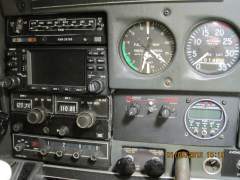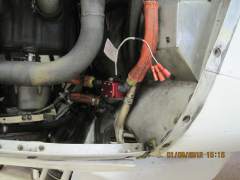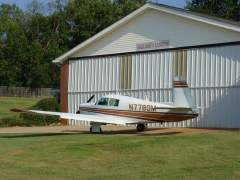-
Posts
4,483 -
Joined
-
Last visited
-
Days Won
58
Content Type
Profiles
Forums
Blogs
Gallery
Downloads
Media Demo
Events
Everything posted by Mooneymite
-
Well, the overvoltage light only comes on once in a blue, blue moon, so it is very hard to track down. I bought the Zeftronic regulator from Spruce, but it is sitting in its box in my baggage compartment since the problem seemed to have "gone away". Yesterday, right over top of ATL at 4500', the darn overvoltage light came on again. I thought I'd just cycle the CB for the alternator and be able to keep my avionics on for the controller, but I see that the CB is one of those that can be re-set if it pops, but can't be pulled and re-set. I had to wait until I was clear of the Class-B, then cycle the master switch. The over-voltage light went out and the alternator has continued to work just fine. I know I should just install the new VR.....but. Question: if the over-voltage light comes on, does the alternator stop charging until re-set? I thought this was the case, but the ammeter did not show any discharge even though I was running the normal load. Strange.
-
Before you invest in a non-WAAS box, you might want to ask Garmin for the support of this item. Word I'm hearing is that if your non-WAAS box breaks, you have to up-grade it to get it repaired..... Just a rumor. Maybe someone knows for sure. The WAAS 430/540 gives you some great IFR advantages.
-

4 bounced landings in a row
Mooneymite replied to SpamPilot's topic in Vintage Mooneys (pre-J models)
This reminds me of an old Marine aviation saying: "A smoking hole is a small price to pay for a $hit-hot approach!". A graceful go-around can make it look like that was the pilot's intention all along! -
Big difference if your airplane is locked in its own hangar, or if it is in a common hangar. IMHO, if it's locked in a hangar only you have access to, you can do 90% of your preflight the night before. In a common hangar, I wouldn't leave anything to chance....nothing.
-

4 bounced landings in a row
Mooneymite replied to SpamPilot's topic in Vintage Mooneys (pre-J models)
Hmmmmm. Perhaps you're starting the flare (rounding out) too high? -
Current CFI in the Atlanta area, but generally limit my activities to "friends and neighbors".
-
Actually, those of us with the electric gear in the 'C' and 'E' models should pay attention to this discussion since the airspeed loads and lubrication/rigging are just as pertinent even if an electric motor is doing the work. I believe that a lot of the gear-wear problems that have turned up in the electrical gear systems (hence the AD) are attributable to excessive loads caused by poor lubrication, poor rigging, high retraction speeds, or a combination of the three. I think the electrics will last a long time if we just minimize the stress on the drive gears. At least I hope so!
-
Yes, I can probably find one in the PMA section of Lowe's if I know what diameter. I do know fine threads are required.
-
Great idea! Every time I sump fuel, I wonder, "What if this thing continues to drain?" Since I don't have a spare quick-drain, maybe just a proper sized bolt to keep the fuel from leaking while I go find a part.....? Does anyone know what a "proper sized bolt" would be? Even if I never use it, it would yield peace of mind when I sump the tanks.
-

4 bounced landings in a row
Mooneymite replied to SpamPilot's topic in Vintage Mooneys (pre-J models)
In my earlier post, I mentioned partial flaps for transitioning newbies until they get the hang of squeekers. Obviously, a proficient pilot can properly land the aircraft at any appropriate flap setting. Full flaps causes a more rapid deceleration which necessitates a more aggressive elevator input; partial flaps mitigates this and allows the new pilot to "get the picture". I am not advocating partial flaps as a panacea....it has been a successful tool in transitioning new pilots. However the transition is not complete until the pilot is a master at all flap settings. Use whatever flap setting is appropriate for conditions. -

4 bounced landings in a row
Mooneymite replied to SpamPilot's topic in Vintage Mooneys (pre-J models)
Dup -

4 bounced landings in a row
Mooneymite replied to SpamPilot's topic in Vintage Mooneys (pre-J models)
I've transitioned several guys to my C model, though I don't pretend to be a Mooney guru. What I've found helps after they have the basics of proper airspeed control are: 1. Begin by using less than full flaps. 2. Make sure they've got enough back trim on final....usually a tad more than the "takeoff" trim. 3. Make sure they get a chirp (or two...) out of the stall warning horn prior to settling onto the runway. 4. Make sure they keep plenty of back pressure on the elevator during roll-out. 5. Don't do touch and goes. #3 and 4 may have to be modified a bit if it's gusty/windy. -
Just wanted to mention that Bendix has a rebuild kit for the L/R/Both/push-to-start switches. Much cheaper than a new switch and an easy one hour job. There is an AD against these switches to check for faults. Mine failed the test; the repair kit was all I needed. I think I still have pictures of the new guts being installed.
-

Proud new Mooney M20C owner
Mooneymite replied to usafhaynes1's topic in Vintage Mooneys (pre-J models)
Congratulations. The C is hard to beat in terms of bang for the buck. Where in VA are you based? Do you have a hangar for your new baby? -
Before exploring the tough stuff....just make sure the nose wheel is perfectly centered.
-

201 with O&N bladders fuel leak in flight.
Mooneymite replied to johnbkeck's topic in Modern Mooney Discussion
I've had bladders for years (installed 1992, I think)....completely problem free. However, about a year after I bought the airplane when the bladders were about seven years old, I did get some evidence of a fuel leak. I did as suggested and removed the access panels and found that all the screws for the bladder access panels had become loose as the seals had compressed over the years. About twenty minutes with a philips screw driver and the problem was gone. Never had another issue. I've talked to other bladder owners who have had exactly this issue at about the same number of years. Simple cause, simple fix. I love those bladders. -
-

Are non-certified devices legal?
Mooneymite replied to bd32322's topic in Miscellaneous Aviation Talk
Wow! What a bunch of scofflaws. Every time I ride an airliner, I'm told that FAR's do not permit operation of anything with a battery and an on/off switch because it will cause an immediate crash and mass carnage. I certainly hope none of this outlandish, dangerous behavior takes place below 10,000'. If you persist in this habit, I hope you don't carry flight attendants with you. They'll tell on you. -
Really? I thought it was dependent on the country. I'm sure I've heard VFR aircraft running all about in foreign lands at night. News to me.
-
Here's an old approach plate, but look at the MSA's.......Beautiful in the daytime, but it can be challenging night, or IMC. .
-
Not necessarily true. 1850 hours was a tough sell because it was "close to TBO". Pricing a plane with a few hours left is problematic because the seller sees value in those few hours, whereas buyers mentally compute "run-out". I know several people who like planes with run-outs because they want to choose the replacement engine. The problem always comes that the seller and prospective buyers can't agree on price. Most sellers are unwilling to discount their planes enough to cover the cost of the run-out. An additional benefit to buying a "run-out" is that often it is not truly run-out, it's just at/beyond TBO. Very often there are many "free" hours left in a high time engine if the plane can be bought at the full run-out discount and then flown beyond TBO. However, I generally agree with the "don't buy a project" adage.
-
Actually, I'd feel safer if everyone was required to carry an assault weapon when travelling on the airlines. Mutually assured destruction (MAD) worked for the entire cold war and some of the participants were a lot more dangerous than the typical airline passenger! "Ma'am, I'm sorry but you can't board until you have your ammo clip completely filled. We want everyone to be equally dangerous."
-

C models with fuel flow instrument installed ?
Mooneymite replied to Lionudakis's topic in Vintage Mooneys (pre-J models)
Here's a picture I took during installation of the EI FP-5L transducer. I have several others if anyone needs installation pics. http://mooneyspace.com/gallery/image/33953-fuel-flow-transducer/ Incidentally, my installation fitted best if I used a "45" on one end and a straight connector on the other end of the transducer. I called EI and they said it was "okay", but it is preferable to have the same type fitting on both ends. My display will sometimes jump a few tenths, but the overall accuracy for fuel burned is very accurate. I never had to adjust the K factor at all. The technical support was great. -

#Mooneymite's album
Images added to a gallery album owned by Mooneymite in Old MooneySpace.com Images
-
From the album: #Mooneymite's album







